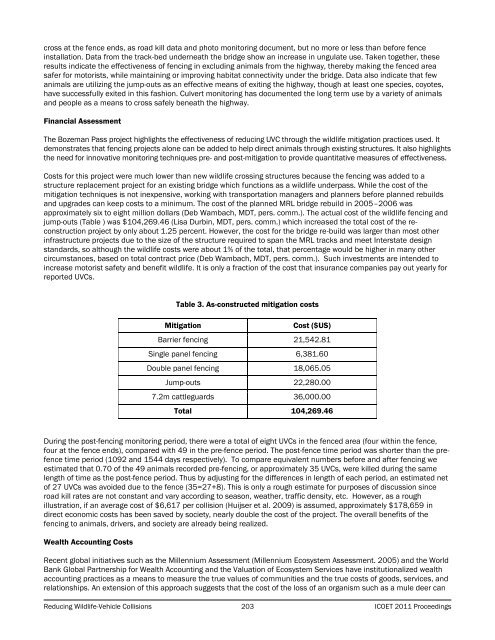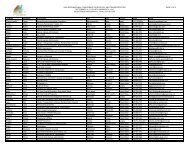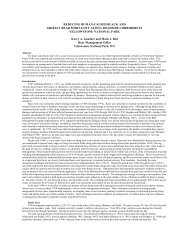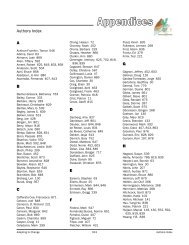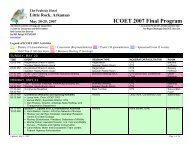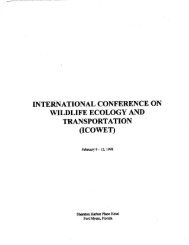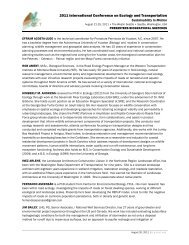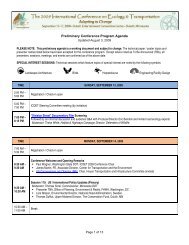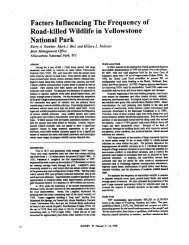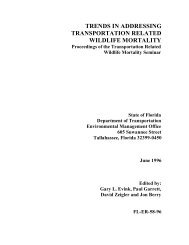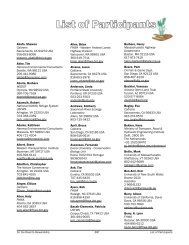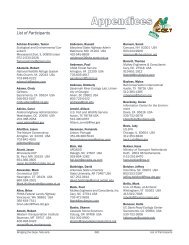COM-1, pages 179-226 - ICOET
COM-1, pages 179-226 - ICOET
COM-1, pages 179-226 - ICOET
Create successful ePaper yourself
Turn your PDF publications into a flip-book with our unique Google optimized e-Paper software.
cross at the fence ends, as road kill data and photo monitoring document, but no more or less than before fenceinstallation. Data from the track-bed underneath the bridge show an increase in ungulate use. Taken together, theseresults indicate the effectiveness of fencing in excluding animals from the highway, thereby making the fenced areasafer for motorists, while maintaining or improving habitat connectivity under the bridge. Data also indicate that fewanimals are utilizing the jump-outs as an effective means of exiting the highway, though at least one species, coyotes,have successfully exited in this fashion. Culvert monitoring has documented the long term use by a variety of animalsand people as a means to cross safely beneath the highway.Financial AssessmentThe Bozeman Pass project highlights the effectiveness of reducing UVC through the wildlife mitigation practices used. Itdemonstrates that fencing projects alone can be added to help direct animals through existing structures. It also highlightsthe need for innovative monitoring techniques pre- and post-mitigation to provide quantitative measures of effectiveness.Costs for this project were much lower than new wildlife crossing structures because the fencing was added to astructure replacement project for an existing bridge which functions as a wildlife underpass. While the cost of themitigation techniques is not inexpensive, working with transportation managers and planners before planned rebuildsand upgrades can keep costs to a minimum. The cost of the planned MRL bridge rebuild in 2005–2006 wasapproximately six to eight million dollars (Deb Wambach, MDT, pers. comm.). The actual cost of the wildlife fencing andjump-outs (Table ) was $104,269.46 (Lisa Durbin, MDT, pers. comm.) which increased the total cost of the reconstructionproject by only about 1.25 percent. However, the cost for the bridge re-build was larger than most otherinfrastructure projects due to the size of the structure required to span the MRL tracks and meet Interstate designstandards, so although the wildlife costs were about 1% of the total, that percentage would be higher in many othercircumstances, based on total contract price (Deb Wambach, MDT, pers. comm.). Such investments are intended toincrease motorist safety and benefit wildlife. It is only a fraction of the cost that insurance companies pay out yearly forreported UVCs.Table 3. As-constructed mitigation costsMitigationCost ($US)Barrier fencing 21,542.81Single panel fencing 6,381.60Double panel fencing 18,065.05Jump-outs 22,280.007.2m cattleguards 36,000.00Total 104,269.46During the post-fencing monitoring period, there were a total of eight UVCs in the fenced area (four within the fence,four at the fence ends), compared with 49 in the pre-fence period. The post-fence time period was shorter than the prefencetime period (1092 and 1544 days respectively). To compare equivalent numbers before and after fencing weestimated that 0.70 of the 49 animals recorded pre-fencing, or approximately 35 UVCs, were killed during the samelength of time as the post-fence period. Thus by adjusting for the differences in length of each period, an estimated netof 27 UVCs was avoided due to the fence (35=27+8). This is only a rough estimate for purposes of discussion sinceroad kill rates are not constant and vary according to season, weather, traffic density, etc. However, as a roughillustration, if an average cost of $6,617 per collision (Huijser et al. 2009) is assumed, approximately $178,659 indirect economic costs has been saved by society, nearly double the cost of the project. The overall benefits of thefencing to animals, drivers, and society are already being realized.Wealth Accounting CostsRecent global initiatives such as the Millennium Assessment (Millennium Ecosystem Assessment. 2005) and the WorldBank Global Partnership for Wealth Accounting and the Valuation of Ecosystem Services have institutionalized wealthaccounting practices as a means to measure the true values of communities and the true costs of goods, services, andrelationships. An extension of this approach suggests that the cost of the loss of an organism such as a mule deer canReducing Wildlife-Vehicle Collisions 203 <strong>ICOET</strong> 2011 Proceedings


